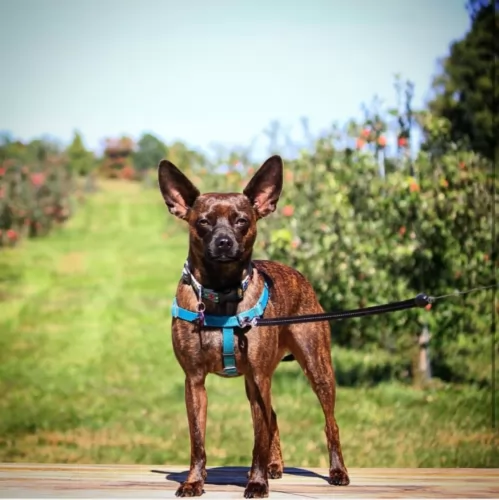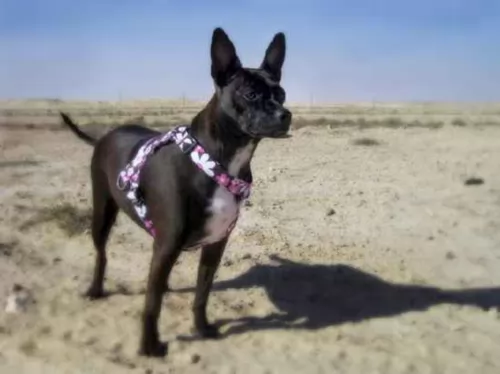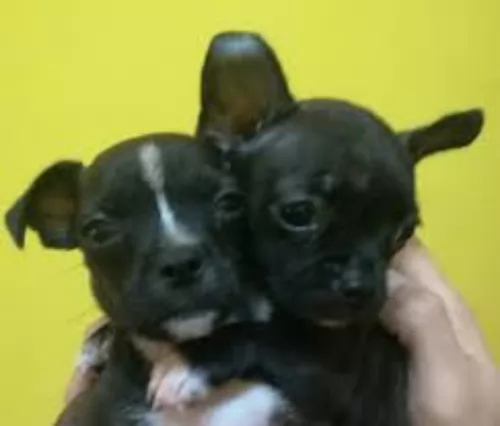 Petzlover
Petzlover Bospin is originated from United States but Havanese is originated from Cuba. Bospin may grow 11 cm / 5 inches higher than Havanese. Both Bospin and Havanese are having almost same weight. Both Bospin and Havanese has almost same life span. Bospin may have less litter size than Havanese. Bospin requires Low Maintenance. But Havanese requires High Maintenance
Bospin is originated from United States but Havanese is originated from Cuba. Bospin may grow 11 cm / 5 inches higher than Havanese. Both Bospin and Havanese are having almost same weight. Both Bospin and Havanese has almost same life span. Bospin may have less litter size than Havanese. Bospin requires Low Maintenance. But Havanese requires High Maintenance
 The Bospin is a fairly new breed of dog and is the result of cross-breeding between the Boston Terrier and the Miniature Pinscher.
The Bospin is a fairly new breed of dog and is the result of cross-breeding between the Boston Terrier and the Miniature Pinscher.
Mixed breed dogs are often healthier than full blood dogs and are becoming a popular choice. The origin of the Bospin is unknown. We know that the Boston Terrier hails from Boston in the USA and the Miniature Pinscher from Germany.
 The only breed of dog that is native to Cuba is the Havanese. These little dogs are great companion animals. Sociable and happy, they are very popular in the United States with urbanites. These happy little pups are a Bichon type of dog which was developed from the “Little White Dog of Havana” or the Blanquito de la Habana which is now extinct.
The only breed of dog that is native to Cuba is the Havanese. These little dogs are great companion animals. Sociable and happy, they are very popular in the United States with urbanites. These happy little pups are a Bichon type of dog which was developed from the “Little White Dog of Havana” or the Blanquito de la Habana which is now extinct.
The Blanquito de la Habana was itself developed from another extinct breed the Bichon Tenerife. Then the Blanquito was bred with the other Bichons and poodles in developing the Havanese. It is believed that some of the first people to settle in Cuba were from Tenerife, an island close to Cuba. In the early part of the sixteenth century, little white dogs were brought to Cuba with these settlers. This dog of Tenerife is believed to be the ancestor of all Bichon breeds.
At that time trade with Cuba was highly restricted by the Spanish and so these dogs developed without any crossing from other breeds from outside the country. They grew to be able to stand hot temperatures and they grew a very unique coat – almost like silk. Their coat is soft and light, while insulating them from the tropical environment.
At this time Cuba was the place to be for Europeans aristocrats on vacation. Unlike the British colonies, Cuba had theatres, operas and palacious. When going back to Europe, many took this little white dog with them to France, Spain and England. The Dog of Havannah was a favorite on European soil as well. Many of these dogs taken to Europe were fawn or parti instead of white. Meanwhile back in Cuba, the bourgeoisie were replacing the aristocracy who themselves would soon be replaced by the Revolution.
During the days of the bourgeoisie, the Havanese became very popular household pets. The breed has been a family pet for the last 150 years. At the same time the breed was very trendy in Europe with Charles Dickens and Queen Victoria owning several. They were by now familiar participants in Europe’s dog shows. Finally, with the Revolution, the bourgeoisie left the country in droves with their little white dogs. A genetic pool was then formed in the US. Gene pool from 11 dogs. All the Havanese in the world are descended from those 11 dogs with the exception of the dogs isolated in Cuba and the US. Today the Havanese is one of the most popular and fastest growing breeds in the world.
 The Bospin, a cross between the smooth haired Boston Terrier and the Miniature Pinscher can actually get any combination and characteristics of either of these two breeds. found in either breed. The Bospin in a small to medium sized dog who can live to be up to 15 years of age.
The Bospin, a cross between the smooth haired Boston Terrier and the Miniature Pinscher can actually get any combination and characteristics of either of these two breeds. found in either breed. The Bospin in a small to medium sized dog who can live to be up to 15 years of age.
He has a short coat, but his looks will essentially depend on which is the more dominant breed. Regardless of which breed he takes after in looks, he will be a muscular little dog with long, lean legs and a long tail. They have small muzzles and a fairly long nose with brown eyes and upright ears. The short coat can be in a number of colours such as brown, beige or brindle, with black and white being a more common colour.
The Bospin’s personality can be a blend of the Boston Terrier and the Miniature Pinscher. They’ve become such popular little dogs, full of fun and just loving to be with their human family. Because they are fairly even tempered, they make excellent family pets and will get on well with children in the home as well as other pets. This is a small dog but he isn’t a yapper. He isn’t going to make a wonderful watchdog as he can be quite friendly with strangers.
 The Havanese is a sturdy little dog, a member of the toy group. They weigh no more than 16 pounds (7.3kg) and his body is longer than it is tall. The breed has a unique topline that is not level, but it is straight. His front legs are longer than his hind legs producing the lively gait everyone is used to seeing with a Havanese. With a full muzzle that tapers to the nose, the Havanese does not seem to be short. The skull’s length is the same as the muzzle’s. The head of the Havanese is round in the back and flat in the front.
The Havanese is a sturdy little dog, a member of the toy group. They weigh no more than 16 pounds (7.3kg) and his body is longer than it is tall. The breed has a unique topline that is not level, but it is straight. His front legs are longer than his hind legs producing the lively gait everyone is used to seeing with a Havanese. With a full muzzle that tapers to the nose, the Havanese does not seem to be short. The skull’s length is the same as the muzzle’s. The head of the Havanese is round in the back and flat in the front.
They have a deep chest, almond shaped eyes that are dark brown and their ears are about halfway down the nose. The long ears hang down the side od the face. They have a long plumed tail that is held high and upward. The standard for the breed and now the laws of the United Kingdom state that there can be no docking of the tail.
 The Bospin is an adaptable dog and can easily fit into farm life or city life. When he is trained and socialized he makes an amicable pet, ready to be a loyal and devoted companion.
The Bospin is an adaptable dog and can easily fit into farm life or city life. When he is trained and socialized he makes an amicable pet, ready to be a loyal and devoted companion.
The Bospin’s personality can actually lean more towards either the Boston Terrier or the Miniature Pinscher, but you’re always going to have fun and games with these entertaining little dogs. They just love the companionship of their human family.
A Bospin needs to be brought into a stable environment so that he can adapt to his new home easily and not be confused by constant changes. Be responsible with your pet and make him one of your family and you’ll be rewarded with an entertaining, fun, loyal 4-legged friend.
 Havanese are highly intelligent and eager to please, and they are easily trained so long as you use only positive methods. This can be a sensitive breed, so care must be taken to not scold them harshly. Socialization from an early age is very important. Expose them calmly to a wide variety of new places and new people, always ensuring that the experiences are positive and not intimidating. Gentle, patient training will result in a wonderful companion dog. They are affectionate with people and get along with other nonaggressive pets.
Havanese are highly intelligent and eager to please, and they are easily trained so long as you use only positive methods. This can be a sensitive breed, so care must be taken to not scold them harshly. Socialization from an early age is very important. Expose them calmly to a wide variety of new places and new people, always ensuring that the experiences are positive and not intimidating. Gentle, patient training will result in a wonderful companion dog. They are affectionate with people and get along with other nonaggressive pets.
The Havanese is the consummate lap dog. Over time they have become the lovable family companion.
The breed is pretty adaptable being able to live as a companion animal in almost any setting. Just don’t expect your Havanese to go hiking or romp with you on 40 acres in the country.
They are intelligent, love to learn but can be a little stubborn. Train them early as they like their habits and its much harder to train an older Havanese.
 Your Bospin is a healthy dog breed, but the most healthiest pets can fall victim to health problems. There are some conditions that are specific to certain types of dogs and smaller breeds have their own set of worrisome dog ailments.
Your Bospin is a healthy dog breed, but the most healthiest pets can fall victim to health problems. There are some conditions that are specific to certain types of dogs and smaller breeds have their own set of worrisome dog ailments.
Smaller dogs or toy breeds have smaller skulls and sometimes their smaller mouths have to find room to house the 42 teeth that dogs have. This over-crowding can lead to dental disease.
This is a common problem in brachycephalic breeds – those dogs that have short, broad muzzles such as the Boston Terrier. Toy breeds are more prone to tracheal collapse, a common cause of airway obstruction in dogs where the dog develops a rasping cough and labored breathing.
This is a developmental orthopedic disease where you see degeneration of the femoral head and which can lead to arthritis. The disease affects young animals and more specifically toy breeds. Your dog will have trouble walking and will usually hold one leg up. Your dog can battle along with pain and arthritis.
 A very healthy breed, the Havanese doesn’t have a lot of health issues, but they are not immune to the problems of small breed dogs. The issues they do have are:
A very healthy breed, the Havanese doesn’t have a lot of health issues, but they are not immune to the problems of small breed dogs. The issues they do have are:
 Because of the short coat and minimum shedding, your Bospin will only require minimal maintenance. Brush him down at least twice a week to keep the short coat free of loose hair and to also keep it shiny and glossy. As with any other dog breed, he should have his teeth brushed at 2 or 3 times a week with special dog toothpaste and toothbrush. Don’t be tempted to use human toothpaste. Check his ears too to make sure they are free of dirt and infection.
Because of the short coat and minimum shedding, your Bospin will only require minimal maintenance. Brush him down at least twice a week to keep the short coat free of loose hair and to also keep it shiny and glossy. As with any other dog breed, he should have his teeth brushed at 2 or 3 times a week with special dog toothpaste and toothbrush. Don’t be tempted to use human toothpaste. Check his ears too to make sure they are free of dirt and infection.
The Bospin is a hybrid breed and because he comes from two energetic dogs, you’ll need to provide him with activities to keep him busy. He will love to go on a walk with you and you can play ball games with him in the garden or even indoors. He isn’t a working dog so he isn’t going to demand too much activity, but it is better to get into the habit of exercising him regularly to keep him in good shape and to maintain his good health.
Bospins need to be fed carefully to avoid weight issues or health problems. Puppies need to eat frequently - 4 times a day. For your Bospin, always go for top quality commercially produced dog foods where meat is the top ingredient. Home made foods are always a wonderful choice for your pet and this can include meat, rice and vegetables.
If you’re unsure about feeding your dog, get advice from your vet. Always have fresh, cool water available and make sure you wash out the water bowl regularly.
 Feed 3 to 4 times per day a high quality dry puppy food for toy or small dogs. Feed ¼ to ½ cup each time.
Feed 3 to 4 times per day a high quality dry puppy food for toy or small dogs. Feed ¼ to ½ cup each time.
Remember these are small dogs and don’t overfeed. Feed a high quality dry food for small or toy dogs. Feed twice a day at about ½ cup each time.
The breed is generally very healthy.
This breed is not an overly active dog, but he does need some exercise. A nice walk once a day or a backyard to play in. They play inside as well as out. Don’t over exercise the Havanese. They do well in obedience and confirmation more so than agility or fly ball